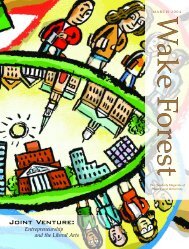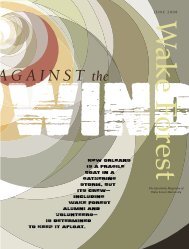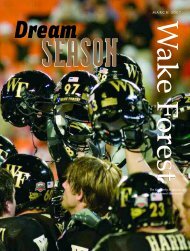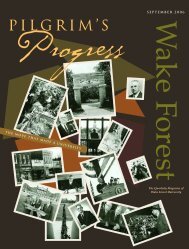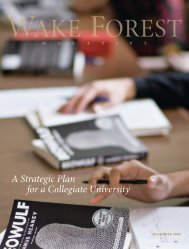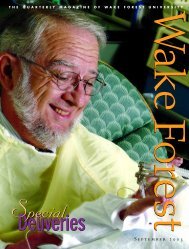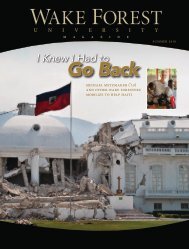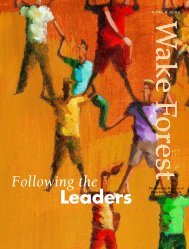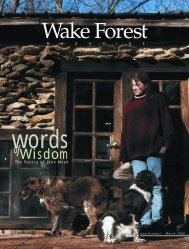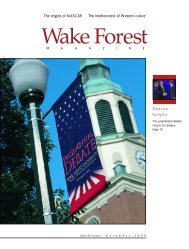Wake Forest Magazine, December 2004 - Past Issues - Wake Forest ...
Wake Forest Magazine, December 2004 - Past Issues - Wake Forest ...
Wake Forest Magazine, December 2004 - Past Issues - Wake Forest ...
You also want an ePaper? Increase the reach of your titles
YUMPU automatically turns print PDFs into web optimized ePapers that Google loves.
Newspaper Children, Leeds City Art Gallery, 1991<br />
before, he paid a specialist to teach him<br />
the basics and assist him in making<br />
his first pair of oversized marble shoes.<br />
Soon he began carving even larger and<br />
more elaborately ornamented variations<br />
on the theme, and making them as<br />
singular works, rather than in left-right<br />
pairs. Finn says, “By themselves the<br />
single shoes are more evocative of a<br />
lost mate, or of nearly forgotten memories.”<br />
He chose the title “Ghosts” for this<br />
series of sculptures “because of their<br />
qualities as spiritual reminders, and<br />
because of their cold, stark, white color.”<br />
Although these pieces lend themselves<br />
well to gallery settings, Finn<br />
demonstrated on two relatively recent<br />
occasions that they can also function<br />
effectively as public art. In the fall<br />
of 2003 he displayed nine of them<br />
in the storefront windows of a longestablished<br />
shoe shop in downtown<br />
Winston-Salem. And late last year he<br />
temporarily installed three of them in<br />
an old cemetery in Charleston as part<br />
of a larger, citywide art exhibition<br />
titled “Thresholds.” In the latter setting<br />
their pristine, white-marble surfaces<br />
appeared luminescent among the much<br />
older, weather-darkened tombstones.<br />
On one level Finn’s “Ghosts” affectionately<br />
parody the “nostalgic spirituality”<br />
long associated with the South. “But<br />
they’re also about recognizing and<br />
appreciating that there’s something<br />
very beautiful and sensual about the<br />
relationship with the past that’s so<br />
much a part of the social order in the<br />
region,” he said.<br />
Finn’s showings of the “Ghosts”<br />
in public settings, his resurrection of<br />
his “Masked Figures” for temporary<br />
placement in pedestrian areas in Raleigh<br />
and Winston-Salem in the last three<br />
years, and his more recent, collaborative<br />
endeavors with students—all reflect<br />
the impact that his public-sculpture<br />
course at <strong>Wake</strong> <strong>Forest</strong> has had on his<br />
own artistic evolution. This dovetailing<br />
of his roles as artist and teacher has<br />
been a welcome development as far as<br />
he’s concerned, particularly because it<br />
has occurred not by contrivance but in<br />
response to the circumstances at hand.<br />
He points out that working with<br />
others is an invariable requirement of<br />
public projects. While he values his<br />
time spent alone in his studio, he says<br />
that he has always been drawn to<br />
the challenges of working with other<br />
people and making art that seeks to<br />
involve “the non-art crowd.” “Deep<br />
subjectivity is not the only mode for<br />
me. I really want to have other people<br />
relate to my art, rather than have it be<br />
just something out of my head,” Finn<br />
says. “Artists have never been as isolated<br />
from society as they have in the<br />
last hundred years, because art has<br />
become completely independent of<br />
previously existing social structures.<br />
In some ways that’s been very good,<br />
but there’s also a cost involved when<br />
you’ve got radical artists on one side<br />
and the political right slamming back<br />
at them from the other.”<br />
In designing and executing artworks<br />
for the public arena, an artist<br />
need not belong to the community<br />
where a piece will be sited, in Finn’s<br />
view, but he or she must have a genuine<br />
understanding and appreciation<br />
for that community and its needs. Finn<br />
points to his own role in the chess table<br />
project. “I’m not a big chess player,”<br />
he says, “but the concept of building<br />
social relationships by playing chess<br />
is something that I believe in.”<br />
Tom Patterson is an independent writer,<br />
art critic, and curator in Winston-Salem.<br />
He has followed David Finn’s art since<br />
the late 1980s, when he began the series<br />
of visual-art columns that he continues<br />
to write weekly for the Winston-Salem<br />
Journal.<br />
DECEMBER <strong>2004</strong> 15



